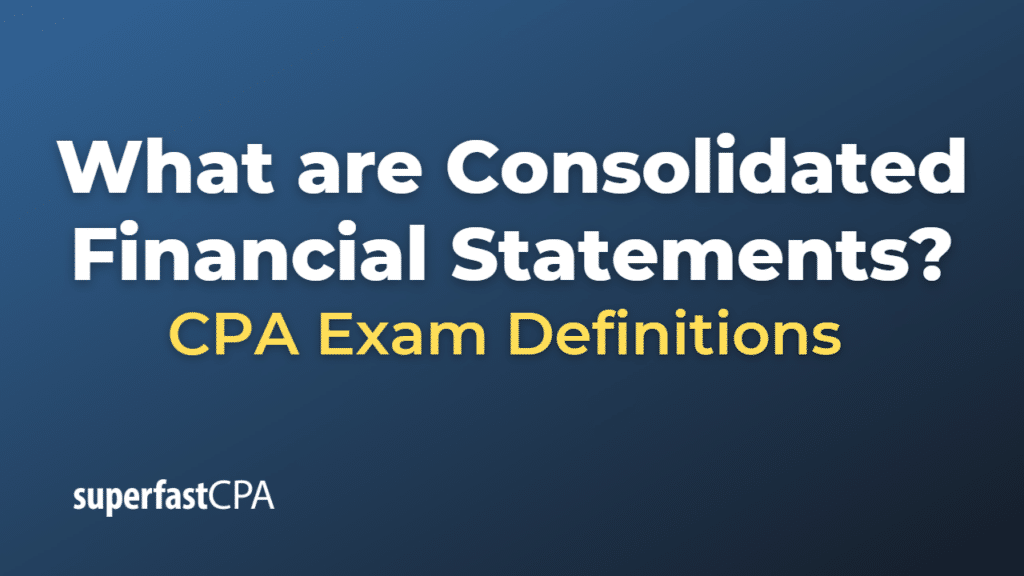Consolidated Financial Statements
Consolidated financial statements are a set of financial statements that present the financial performance and position of a parent company and its subsidiaries as if they were a single entity. The purpose of consolidated financial statements is to provide a comprehensive view of the entire group’s financial health, enabling investors, creditors, and other stakeholders to assess the group’s overall performance, financial position, and cash flows.
The process of preparing consolidated financial statements involves combining the financial statements of the parent company and its subsidiaries, eliminating any intercompany transactions and balances, and adjusting for non-controlling interests. The main components of consolidated financial statements include:
- Consolidated Balance Sheet: This statement presents the combined assets, liabilities, and shareholders’ equity of the parent company and its subsidiaries, eliminating any intercompany transactions and balances.
- Consolidated Income Statement: This statement shows the combined revenues, expenses, and net income (or loss) of the parent company and its subsidiaries, eliminating any intercompany revenues and expenses.
- Consolidated Statement of Comprehensive Income: This statement provides a summary of the group’s total comprehensive income, which includes net income and other comprehensive income items, such as unrealized gains or losses on certain financial instruments and foreign currency translation adjustments.
- Consolidated Statement of Changes in Equity: This statement presents the changes in the group’s shareholders’ equity, including non-controlling interests, during a specific period. It shows the beginning balances, adjustments for transactions such as dividends and share issuances, and the ending balances.
- Consolidated Statement of Cash Flows: This statement presents the group’s cash inflows and outflows during a specific period, classified into operating, investing, and financing activities. It shows how the group generates and uses cash, helping stakeholders assess the group’s liquidity and cash management.
Consolidated financial statements are required for publicly traded companies with subsidiaries, and they must be prepared in accordance with the relevant accounting standards, such as the International Financial Reporting Standards (IFRS) or the US Generally Accepted Accounting Principles (US GAAP). These statements provide a more accurate and complete picture of a group’s financial performance and position than separate financial statements for the parent company and its subsidiaries, allowing stakeholders to make better-informed decisions about investing, lending, or conducting business with the group.
Example of Consolidated Financial Statements
Let’s consider a hypothetical example to illustrate the concept of consolidated financial statements:
Parent Company X is a publicly traded corporation that owns 100% of Subsidiary Y and 75% of Subsidiary Z. To provide a comprehensive view of the group’s financial health, Parent Company X must prepare consolidated financial statements, which include the financial performance and position of both Subsidiary Y and Subsidiary Z along with its own.
Suppose the individual income statements for the year 20XX for the three companies are as follows:
Parent Company X:
- Revenues: $1,000,000
- Expenses: $700,000
- Net Income: $300,000
Subsidiary Y:
- Revenues: $500,000
- Expenses: $400,000
- Net Income: $100,000
Subsidiary Z:
- Revenues: $800,000
- Expenses: $600,000
- Net Income: $200,000
To prepare the consolidated income statement, Parent Company X would:
- Combine the income statements line by line:
- Total Revenues: $1,000,000 (Parent Company X) + $500,000 (Subsidiary Y) + $800,000 (Subsidiary Z) = $2,300,000
- Total Expenses: $700,000 (Parent Company X) + $400,000 (Subsidiary Y) + $600,000 (Subsidiary Z) = $1,700,000
- Eliminate any intercompany transactions, such as sales or services provided between Parent Company X and its subsidiaries (assume there are none in this example).
- Adjust the consolidated net income for non-controlling interests. In this example, Parent Company X owns 75% of Subsidiary Z, so the non-controlling interest would represent 25% of Subsidiary Z’s net income ($200,000 * 25% = $50,000).
The consolidated income statement would show:
- Total Revenues: $2,300,000
- Total Expenses: $1,700,000
- Consolidated Net Income: $600,000 ($300,000 Parent Company X + $100,000 Subsidiary Y + $150,000 (75% of Subsidiary Z))
- Non-controlling interests: $50,000
By preparing consolidated financial statements, Parent Company X provides a more comprehensive view of the group’s financial performance, which helps investors, creditors, and other stakeholders make better-informed decisions about investing, lending, or conducting business with the group.













